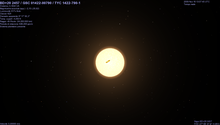| Observation data Epoch J2000.0 Equinox J2000.0 | |
|---|---|
| Constellation | Leo |
| Right ascension | 10 16 44.8672 |
| Declination | +19° 53′ 29.010″ |
| Apparent magnitude (V) | 9.75 |
| Characteristics | |
| Spectral type | K2II |
| B−V color index | +1.25 |
| Astrometry | |
| Proper motion (μ) | RA: −35.952(19) mas/yr Dec.: −29.961(18) mas/yr |
| Parallax (π) | 0.6787 ± 0.0200 mas |
| Distance | 4,800 ± 100 ly (1,470 ± 40 pc) |
| Details | |
| Mass | ≤1 M☉ |
| Radius | 49±26 R☉ |
| Luminosity | 1,479 L☉ |
| Surface gravity (log g) | 1.51 cgs |
| Temperature | 4,127±17 K |
| Metallicity | −1.00±0.07 dex |
| Age | ≥8 Gyr |
| Other designations | |
| PPM 127264 | |
| Database references | |
| SIMBAD | data |
| Exoplanet Archive | data |

BD+20 2457 is a 10th-magnitude K-type bright giant star located approximately 4,800 light-years away in the constellation of Leo. The name refers to the Bonner Durchmusterung star catalog. This star contains a very small amount of metals, containing only 10% as enriched with elements heavier than hydrogen and helium as the Sun.
On June 10, 2009, two planets were announced to be orbiting the star, with minimum masses 21.4 and 12.5 times the mass of Jupiter and orbital periods of 380 and 622 days for the inner and outer planets, respectively. A dynamical analysis reveals that the proposed system is unstable on astronomically short timescales and so the suggested planetary configuration is unlikely to be correct: further data is needed to determine a physically plausible explanation for the radial velocity variations. This conclusion of a dynamical unstable system depends on the planets masses. A later study found lower masses, which could increase the long-term stability.
A study from 2021 using Gaia identified BD+20 2457 as a halo star on a retrograde orbit around the Milky Way with a highly eccentric orbit. The researchers constrain the minimum age and the stars upper mass to ≥8 billion years and ≤1 M☉. This decreases the mass of the planets to 13 MJ (BD+20 2457 b) and 7 MJ (BD+20 2457 c). The chemical abundances also suggest that the star formed from the Milky Ways protodisk. As an alternative it could have formed from debris of the Gaia-Enceladus galaxy as it merged with the Milky Way. If BD+20 2457 formed from the Gaia-Enceladus debris, then the star and its planets could have an extragalactic origin.
References
- ^ Vallenari, A.; et al. (Gaia collaboration) (2023). "Gaia Data Release 3. Summary of the content and survey properties". Astronomy and Astrophysics. 674: A1. arXiv:2208.00211. Bibcode:2023A&A...674A...1G. doi:10.1051/0004-6361/202243940. S2CID 244398875. Gaia DR3 record for this source at VizieR.
- ^ Niedzielski, A.; et al. (2009). "Substellar-mass Companions to the K-dwarf BD+14 4559 and the K-giants HD 240210 and BD+20 2457". The Astrophysical Journal. 707 (1): 768–777. arXiv:0906.1804. Bibcode:2009ApJ...707..768N. doi:10.1088/0004-637X/707/1/768. S2CID 16877069.
- ^ Perottoni, Hélio D.; Amarante, João A. S.; Limberg, Guilherme; Rocha-Pinto, Helio J.; Rossi, Silvia; Anders, Friedrich; Borbolato, Lais (2021-05-01). "Searching for Extragalactic Exoplanetary Systems: The Curious Case of BD+20 2457". The Astrophysical Journal. 913 (1): L3. arXiv:2104.08306. Bibcode:2021ApJ...913L...3P. doi:10.3847/2041-8213/abfb06. ISSN 0004-637X.
- ^ Horner, J.; Wittenmyer, R. A.; Hinse, T. C.; Marshall, J. P. (2014). "A dynamical investigation of the proposed BD +20 2457 system". Monthly Notices of the Royal Astronomical Society. 439 (1): 1176–1181. arXiv:1401.2793. Bibcode:2014MNRAS.439.1176H. doi:10.1093/mnras/stu081. S2CID 54534748.
| Constellation of Leo | |||||||||||||
|---|---|---|---|---|---|---|---|---|---|---|---|---|---|
| Stars |
| ||||||||||||
| |||||||||||||
| Galaxies |
| ||||||||||||